| NOTE: Click on any of the photos that accompany this article toview larger, higher-resolution versions. |
Afew summers ago, I flew my 1978 Grumman Yankee (affectionately named The Banana Slug)from Watsonville, California, to an AmericanYankee Association (AYA) national convention in Cable, Wisconsin. I then flew toOshkosh for the EAA fly-in which I had never seenbefore. The comments I received during the trip ranged between "you really flew allthat way in that small airplane?" to "you must be out of out mind." Thefact that some of these comments came from people who owned airplanes similar to mineconvinced me that many owners of two place airplanes are unnecessarily restricting theirrange of travel and missing out on a great deal of fun.
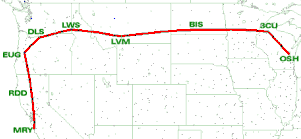 It is possible to fly long distances in a two place airplane without risking life andlimb. It is possible to have a great deal of fun doing so. I have flown my plane throughBaja California and had made a previous trip back to lowa. I thought that a detailedaccount of this year’s trip might convince some other owners of smaller airplanes to dragout the maps and give it a try.
It is possible to fly long distances in a two place airplane without risking life andlimb. It is possible to have a great deal of fun doing so. I have flown my plane throughBaja California and had made a previous trip back to lowa. I thought that a detailedaccount of this year’s trip might convince some other owners of smaller airplanes to dragout the maps and give it a try.
The trip this year took us upthrough Oregon where a right turn was made at Portland, and then easterly through Idaho,Montana, South Dakota, Minnesota and on to Wisconsin. This route was about 300 miles morethan a more direct routing but some friends had used it two years before in a similarplane and said it was a pretty flight and wasn’t as high as some alternatives. I say usbecause my wife flew out with me and, as prearranged, I flew back by myself. Having apassenger was an interesting situation since the extra weight obviously affectsperformance and requires even more careful flight planning. Perhaps even more importantwas the fact that my wife had never flown more than 200 miles in the Slug and reserved theright to get out at any major airport and ride one of United’s oil burners the rest of theway! The return trip was through lowa, Kansas, New Mexico, Arizona and across theCalifornia desert to the welcome sight of the Monterey Bay. Total flight time was justover forty hours. I had a great deal of fun, no major troubles, and collected an AYAtrophy for "Longest Distance Flown, 2-Place."
Picking the Route
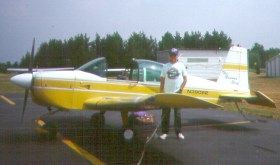 I always start a trip by dragging out an automotive road atlas. This helps me get aidea of where I’m going (this always seems a bit hard to gather from sectionals and WACsand may reflect the fact that I’ve only been flying five years) and points out major roadsystems. This has the advantage that many major roads though the mountains follow naturalvalleys. For instance, this year we were following Interstate 90 through Montana, Thishighway is fairly low and quite scenic in that you are above a wide valley but you havelarge mountains off each wing-tip.
I always start a trip by dragging out an automotive road atlas. This helps me get aidea of where I’m going (this always seems a bit hard to gather from sectionals and WACsand may reflect the fact that I’ve only been flying five years) and points out major roadsystems. This has the advantage that many major roads though the mountains follow naturalvalleys. For instance, this year we were following Interstate 90 through Montana, Thishighway is fairly low and quite scenic in that you are above a wide valley but you havelarge mountains off each wing-tip.
Next I drag out my flight case planning map. This allows you to translate your plannedroute to standard aviation navigational aids such as VORs and NDBs. It also tells you whatsectionals you will need. This is probably a good point for several map relateddigressions. I always use sectionals even though they cost a bit more than a WAC. Itstempting to just use a WAC when you’re going quickly through a area and won’t need the mapagain but I think its a false economy. I like the additional detail that a sectionalprovides and with a slower airplane, you feel that you are making good progress when youhave to keep changing your position on the map. Plus a sectional gives you twice as manyopportunities for that trivial act which is such a joy to the long distance flyer; thechance to toss a map you are not going to need any more into the back of the airplane! Ialso think it is a good idea to purchase sectionals that are close to your planned routeof flight. It may seem stupid to buy a map that you are not planning to use. But weathercan often cause a change in plans, and I don’t want to limit my options to only thoseareas I have maps for or go flying off into an area where I don’t have a map. The slightextra expense is well worth the added flexibility.
With sectionals in hand, it is now time for the fun part detailed route planning andfiguring out each fuel stop. My plane holds 22 gallons usable and burns about six gallonsper hour. This means that three hours is the outside amount of time I will ever fly andtwo hours and one half to two hours and forty five minutes is a more comfortable figure.I’ve flown for longer than three hours and one time put in 19.2 gallons but it’s hard onthe nerves and I’ve never had the determination to get into the habit of running one wingtank dry. I especially didn’t want to do that on this trip as I knew my white knuckledwife wouldn’t take kindly to motor stoppages or even a few seconds. It took her years toget used to the motor dropping off a bit when I leaned out even though I always told herif was about to happen!
What’s Your Hurry?
I feel that this is the point where you must make your most important decision of theflight. If you are going to fly a small plane a long distance, you must decide why you aredoing it. If you’re in a big hurry, you’d probably be better off flying commercial orrenting a larger plane. Same comment holds true if you absolutely, positively have to besomewhere by a fixed time. If you are going somewhere but believe that a major part of thetrip is the getting there and you’re willing to be flexible, then you’ll probably have agreat time in your plane. I always try to set a very conservative schedule and then leaveone extra day. This gives me complete freedom and keeps my head out of the"I’ve got to get to … by tonight" mode.
I also try not to discuss my plans with people who fly large planes as they invariablygo on about how they can fly as far on one fuel stop as I will in a day or two. This kindof cruel torment gets me feeling inferior and definitely grumpy. I always snap back that Idon’t want to get there quickly; I enjoy flying and will still be up in the air having funwhen they’re sitting in some barren motel room.
Another mindset that can really help is to decide that you are going to take things asthey come. If you’re forced down earlier than you planned and there really is no safealternative, then just accept it and make the best of where you are. No matter howdesolate the town is, there are lots of worse places somewhere else in the world wherepeople spend their whole lives. One night in Hell Hole Montana won’t kill you. Trying toget out of there prematurely might.
We’re Off!
We set off around noon on a Wednesday. We had planned on getting an early start thenext day, but summer fog is a constant problem where we live (I’m a VFR pilot) We couldget free that day so we decided a casual first day would get us a little way along andwe’d just stop where it made sense. I’d checked the winds at six and nine thousand and haddecided on 8500 feet even though it wasn’t really necessary in California. But this gaveus a tail wind and would allow me to see how the plane performed with two people andbaggage. Incidentally, we tried to reduce our baggage as much as possible by shipping somethings to friends in Wisconsin. We shipped everything we would individually need once wehad separated. We took only what we would need for the first few days on the road.Variations on this trick can be used depending on your schedule; you might ship stuff to ahotel you know you will stay at and then mail your dirty clothes home to yourself. Theimportant thing is to take as little as possible. If you have to, buy clean underwear andsocks one the road (I did!).
As we climbed out, I kept careful track on our performance at each thousand foot level.I wanted to have a good idea of how we were going to perform in the mountains as theYankee is not a great airplane in high, hot and heavy loaded conditions. If you respectits capabilities, its a great plane but you have to always remember its limitations, Wehad a good ride up to Redding, CA; everything in the back shook down to its lowest energylevel and I had some idea of what our performance was going to be.
When we landed at Redding, the temperature was in the upper nineties so we made a quickdash into the FBO to refill our plastic container with ice and water. While relaxing inthe air conditioning, I went over the next leg of the night and also calculated thedensity altitude. Redding is low enough that I knew we would have no problems getting offbut I always calculate density altitude at each stop. This gives you a good idea ofexactly what you are facing. A thousand foot airport can easily have a density altitude ofabove four thousand. A four thousand foot can easily be at 8000. At some point, it makesmore sense to give it up for the day and go find a cold beer and a swimming pool. You’reon vacation, remember!
Our climb out was sluggish but acceptable and I used a trick a sail plane pilot taughtme several years ago in Reno. Faced with a high, hot "but I really want to gethome" situation, I consulted several locals. The sail plane pilot pointed out severallocal hills that he would he would fly over because they always had good lift. I flew tothem and used them just like a sail plane pilot; tight turns keep me in the ascendingthermals and gave me the altitude I needed to get over the Sierras. Almost any hot areawill have spots where the air is rising and spots where the air is sinking. You want tostay in the areas of lift for as long as possible (consistent with visibility and enginecooling constraints) and you want to get through areas of sink as quickly as possible.Using these techniques can often double the performance of a small airplane and help breakthe monotony of a long climb to altitude.
Our next two and one half hour leg took us for the first time into Oregon and providedsome nice mountains and green hills for diversion. Eugene seemed to be a good spot tospend the night, so we landed, canceled our flight plan, made fueling arrangements andfound a hotel that would pick us up a! the airport. While waiting for the car to arrive wechecked with the locals about what we could expect for morning weather as weather reportsduring the day had indicated IFR conditions until about two hours before we arrived. Thelocals said that this was fairly typical for summer and, unfortunately, the next morningwould prove them right.
Escape From The Coast
We arose to find a heavy layer of status at about 1200 feet. We ate a leisurelybreakfast and took our time getting to the airport but things had improved only slightlyby ten thirty. Thus began several hours of fidgeting, calling FSS, looking at the sky,mutual discussions about should we go or not. You know! Every VFR pilot faces this onextended trips and its always hard to decide whether you are exercising proper caution andhave just become an old poop who is afraid to fly in anything other than perfectconditions.
It is inevitable that you will have to fly in other than perfect conditions but Ialways set up rules with myself before I go anywhere. The first rule is that I make my owngo/no-go decision. Even if others are going, I try to decide if the conditions are rightfor my skill level. I’m a better pilot than some; worse than a whole lot of others, Inaddition, I don’t know how strongly others want to keep on living; I do know how my mindworks. There are times I’m not sure about others. My second rule is that if I go, I alwayswant at least one escape route. I want one airport that I know is good and will remaingood. My escape airport may change but I always want one or I won’t go. My third rule isthat I won’t break the regs. I know others fly in clouds but that’s not for me.
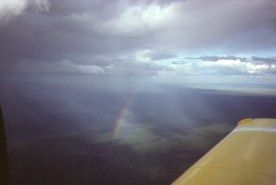 With thosethoughts in mind, we finally headed north below a solid layer of stratus. I knew that ifwe could reach Portland and the Columbia River, the weather improved rapidly as we wouldhead east. The status was a local condition caused by marine air blowing in from thecoast. The next hour of flying required both of us actively looking out the windows fortraffic and several calls to control towers for permission to Transit their traffic areas.Finally we reached the beautiful Columbia River gorge and, as predicted, the weatherquickly went clear. Afterward, we were glad we waited as long as we did but were alsohappy that we had finally left as the weather had forced us to stay low over theWillamette valley and the flight had been very beautiful if a bit hazy.
With thosethoughts in mind, we finally headed north below a solid layer of stratus. I knew that ifwe could reach Portland and the Columbia River, the weather improved rapidly as we wouldhead east. The status was a local condition caused by marine air blowing in from thecoast. The next hour of flying required both of us actively looking out the windows fortraffic and several calls to control towers for permission to Transit their traffic areas.Finally we reached the beautiful Columbia River gorge and, as predicted, the weatherquickly went clear. Afterward, we were glad we waited as long as we did but were alsohappy that we had finally left as the weather had forced us to stay low over theWillamette valley and the flight had been very beautiful if a bit hazy.
We had planned to fly up near Mt. St. Helens but the weather had made that impossible.Unfortunately, I didn’t really consider that we were taking a shorter route and went aheadand set up for the planned fuel slop at The Dalles in Oregon. This town has twoattributes; a strange name and the fact that it is the wind surfer headquarters or theU.S.
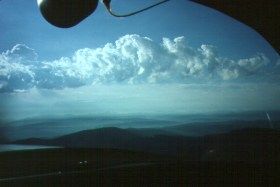 I knew that we were in for aninteresting time when I saw the whitecaps buffeting the wind surfers on the river andunicom said the wind was 22 gusting to thirty six. I set up a cautious approach and wasread to abort the whole thing if the wind got too weird. Unfortunately, it wasn’t until Iwas climbing out that I finally realized that I had enough fuel to have continued on to aslightly less windy stop! Oh well, a little cross wind practice helps keep the skill levelup. And I’ve found I can use it as a bragging point with more rational pilots who give theplace a wide berth to say "Oh yes, I’ve landed there with the wind gusting to 36 anddidn’t even have a problem in that ‘tiny little’ airplane."
I knew that we were in for aninteresting time when I saw the whitecaps buffeting the wind surfers on the river andunicom said the wind was 22 gusting to thirty six. I set up a cautious approach and wasread to abort the whole thing if the wind got too weird. Unfortunately, it wasn’t until Iwas climbing out that I finally realized that I had enough fuel to have continued on to aslightly less windy stop! Oh well, a little cross wind practice helps keep the skill levelup. And I’ve found I can use it as a bragging point with more rational pilots who give theplace a wide berth to say "Oh yes, I’ve landed there with the wind gusting to 36 anddidn’t even have a problem in that ‘tiny little’ airplane."
From The Dalles eastward, we quickly learned that it’s only the western parts of Oregonthat are green. The Eastern parts of Oregon and Washington are desolate. So we bouncedalong for the rest of our fuel load and were quite happy to call it a day at Lewiston,Idaho. The scenery around Lewiston gave hope of a attractive flight tomorrow although Iwas a bit nervous as I knew it held the highest and most dangerous territory we would haveto cross in the trip.
Across The Divide
We were up the next morning well before the crack of dawn as I wanted to be well on myway by the time it got hot. We hitched a ride out to the airport in the hotel van with theearly morning crew of a commuter airline. They looked more like uniformed escapees fromSesame Street than something out of an Ernie Gann novel but I guess that’s the curse ofgrowing older!
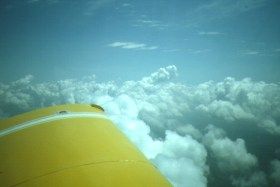 A quick check with Walla Walla FSSand we were on our way. It was a beautiful morning but I was full of apprehension (which Itried to keep to myself) as I had never gone over any serious mountain terrain before andI hoped I was doing the right thing. The cool air gave us a good climb and we were soonleaning out at 9500 feet as the terrain below us got more and more rugged. I was nervouslychecking both the loran and the VOR as I expected that the loran might go out on mesomewhere on the way to Missoula due to the dreaded mid-continent gap. (This was beforethey closed the loran gap, and long before we had handheld GPS!)
A quick check with Walla Walla FSSand we were on our way. It was a beautiful morning but I was full of apprehension (which Itried to keep to myself) as I had never gone over any serious mountain terrain before andI hoped I was doing the right thing. The cool air gave us a good climb and we were soonleaning out at 9500 feet as the terrain below us got more and more rugged. I was nervouslychecking both the loran and the VOR as I expected that the loran might go out on mesomewhere on the way to Missoula due to the dreaded mid-continent gap. (This was beforethey closed the loran gap, and long before we had handheld GPS!)
Sure enough, about 45 minutes later, in the midst of the roughest possible terrain, thewarning light started blinking and it was obvious that if we found our way to Missoula, itwas going to be via the VOR and not the loran. The terrain below us was beautiful, ruggedmountains but I must admit I wasn’t enjoying it as much as I hoped because I used to workin an automobile factory and every time I looked down I hoped that Lycoming employees weremore highly motivated than my friends at The Buick used to be. Good places to land justdidn’t exist within eyesight let alone gliding distance.
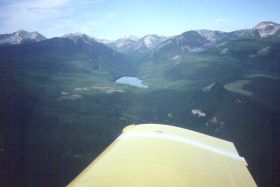 Happily, in a little overan hour the terrain smoothed out a bit and it was obvious that we were approachingMissoula. I finally started to breath again and think great philosophical thoughts abouthow marvelous it is to be a pilot; put yourself in a little bit of danger; scare yourselfjust a little bit; see the world in a way few others ever do; and to do it all beforeseven in the morning! Our plans called for us to quickly refuel and be on our way but Imade a vow that the next time I passed this way, I would spend a few days as the areaaround Missoula was fantastic with mountain valleys radiating out from the central bowlholding the town. I had few worries about the rest of the day as I knew the hardest partwas behind us and all I had to do for the next few hours was to follow Interstate 90 toBillings.
Happily, in a little overan hour the terrain smoothed out a bit and it was obvious that we were approachingMissoula. I finally started to breath again and think great philosophical thoughts abouthow marvelous it is to be a pilot; put yourself in a little bit of danger; scare yourselfjust a little bit; see the world in a way few others ever do; and to do it all beforeseven in the morning! Our plans called for us to quickly refuel and be on our way but Imade a vow that the next time I passed this way, I would spend a few days as the areaaround Missoula was fantastic with mountain valleys radiating out from the central bowlholding the town. I had few worries about the rest of the day as I knew the hardest partwas behind us and all I had to do for the next few hours was to follow Interstate 90 toBillings.
This was to be my undoing. The Interstate follows a natural valley that is severalmiles wide. This gives you a fantastic ride because you have this big, flat landing stripbelow you (concrete or grass, take your pick) with breathtaking mountain scenery offeither wing tip. Unfortunately, I got so busy sightseeing that we wandered off the mostdirect route and I have to admit that for a few minutes we weren’t even going in the rightdirection.
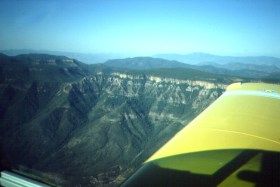 The bottom line of allthis sloppy behavior was that I rapidly realized that I was going to either drag intoBillings with minimal fuel or I was going to make a quick stop somewhere to top off. SinceI figured my rider wouldn’t understand the thrill that comes from running a tank dry tomake sure you’ve gotten every single drop out of it, I decided that a quick stop inLivingston, MT was required. Unfortunately, the altitude and temperature riding in thenineties quickly made it obvious that the density altitude was at the limits for oneperson in the airplane and certainly wasn’t safe for two pizza loving souls to attempt. Idecided we would chat with the locals (FSS and FBO) for a few hours until the inevitableafternoon thunderstorm came along to cool things off and then we’d be on our way.Everything went hotly, boringly as planned until it became obvious that the 3 PMthunderstorm was a real doozy and while it was great fun to watch, it was very obviousthat all flying was over for the day. We finally accepted a gracious offer of a ride intotown and proved the wisdom of leaving plenty of time to get where you are going if you’regoing to do it in a small plane. The good news was that Livingston is a pretty town withlots of railroad history. Since I’m a fan of anything that has an engine, the stop wasmost enjoyable and I was almost able to convince my wife that I had planned the wholething that way,
The bottom line of allthis sloppy behavior was that I rapidly realized that I was going to either drag intoBillings with minimal fuel or I was going to make a quick stop somewhere to top off. SinceI figured my rider wouldn’t understand the thrill that comes from running a tank dry tomake sure you’ve gotten every single drop out of it, I decided that a quick stop inLivingston, MT was required. Unfortunately, the altitude and temperature riding in thenineties quickly made it obvious that the density altitude was at the limits for oneperson in the airplane and certainly wasn’t safe for two pizza loving souls to attempt. Idecided we would chat with the locals (FSS and FBO) for a few hours until the inevitableafternoon thunderstorm came along to cool things off and then we’d be on our way.Everything went hotly, boringly as planned until it became obvious that the 3 PMthunderstorm was a real doozy and while it was great fun to watch, it was very obviousthat all flying was over for the day. We finally accepted a gracious offer of a ride intotown and proved the wisdom of leaving plenty of time to get where you are going if you’regoing to do it in a small plane. The good news was that Livingston is a pretty town withlots of railroad history. Since I’m a fan of anything that has an engine, the stop wasmost enjoyable and I was almost able to convince my wife that I had planned the wholething that way,
It’s All Downhill From Here
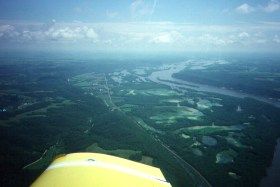 The next morning opened with ashort ride to our goal from yesterday and it was obvious that while we had many miles togo, the terrain was now rapidly trending to flat and our beautiful clear skies wererapidly giving way to the haze that is typical of the Midwest.
The next morning opened with ashort ride to our goal from yesterday and it was obvious that while we had many miles togo, the terrain was now rapidly trending to flat and our beautiful clear skies wererapidly giving way to the haze that is typical of the Midwest.
After a most enjoyable overnight with friends in South Dakota, we bounced our waythrough the haze (we went through the Minneapolis Class B and never saw the city!) andeventually touched down in Wisconsin. It was a great feeling to know that we had made itsafely to our destination, we had mainly enjoyed ourselves and we were still talking toeach other. I dropped my wife off at friends and excitedly made my way to the AYAconvention and then on to Oshkosh.
At Last, Oshkosh
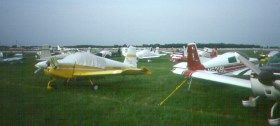 I had never been to Oshkosh beforeso I had very mixed concepts of what I was getting into. I knew that the air would be fullof airplanes so I was very nervous about how the arrival at Ripon and subsequent trackingalong the railroad tracks would work. I studied the arrival instructions so many timesthat I almost had them memorized. The bottom line was that the joint efforts of the FAAand the EAA produce a system that works marvelously. Following the strict dictum of nottalking when you are spoken to by the controllers but merely rocking your wings toindicate you heard them produces a system which can handle an amazing amount of traffic ina very short time. I have been a lot more worried going into much smaller airshows inCalifornia than I was at Oshkosh.
I had never been to Oshkosh beforeso I had very mixed concepts of what I was getting into. I knew that the air would be fullof airplanes so I was very nervous about how the arrival at Ripon and subsequent trackingalong the railroad tracks would work. I studied the arrival instructions so many timesthat I almost had them memorized. The bottom line was that the joint efforts of the FAAand the EAA produce a system that works marvelously. Following the strict dictum of nottalking when you are spoken to by the controllers but merely rocking your wings toindicate you heard them produces a system which can handle an amazing amount of traffic ina very short time. I have been a lot more worried going into much smaller airshows inCalifornia than I was at Oshkosh.
The Oshkosh show itself is almost impossible to describe. All that I can say is thatjust as every Moslem believed that they must make at least one trip during their life toMecca; I believe that you can’t truly call yourself a pilot unless you have been toOshkosh. There is always something to see or do and the interaction of all those whoattend the show provides an interesting insight into how great a society can be when ithas enlightened leaders who bring out the best in the population. The cleanliness of thegrounds and the friendliness of the people will rapidly make a deep impression on you thatyou’ll remember fondly many times in the future.
Four completely-filled days later, the Slug and I departed Oshkosh, pointed our nose ina Westerly direction and climbed slowly into the hazy Wisconsin skies. My head was reelingwith all I had seen and done. My body had a warm happy glow and the back of the plane wasfilled with many brand new flying T shirts. Even though I knew that we had many miles togo before we’d again flirt with the Watsonville, CA fog, my thoughts were drifting forwardin time to some future July when the Slug and I would again head East and spend a fewhappy days camped along the edge of OSH runway 9-27.


































